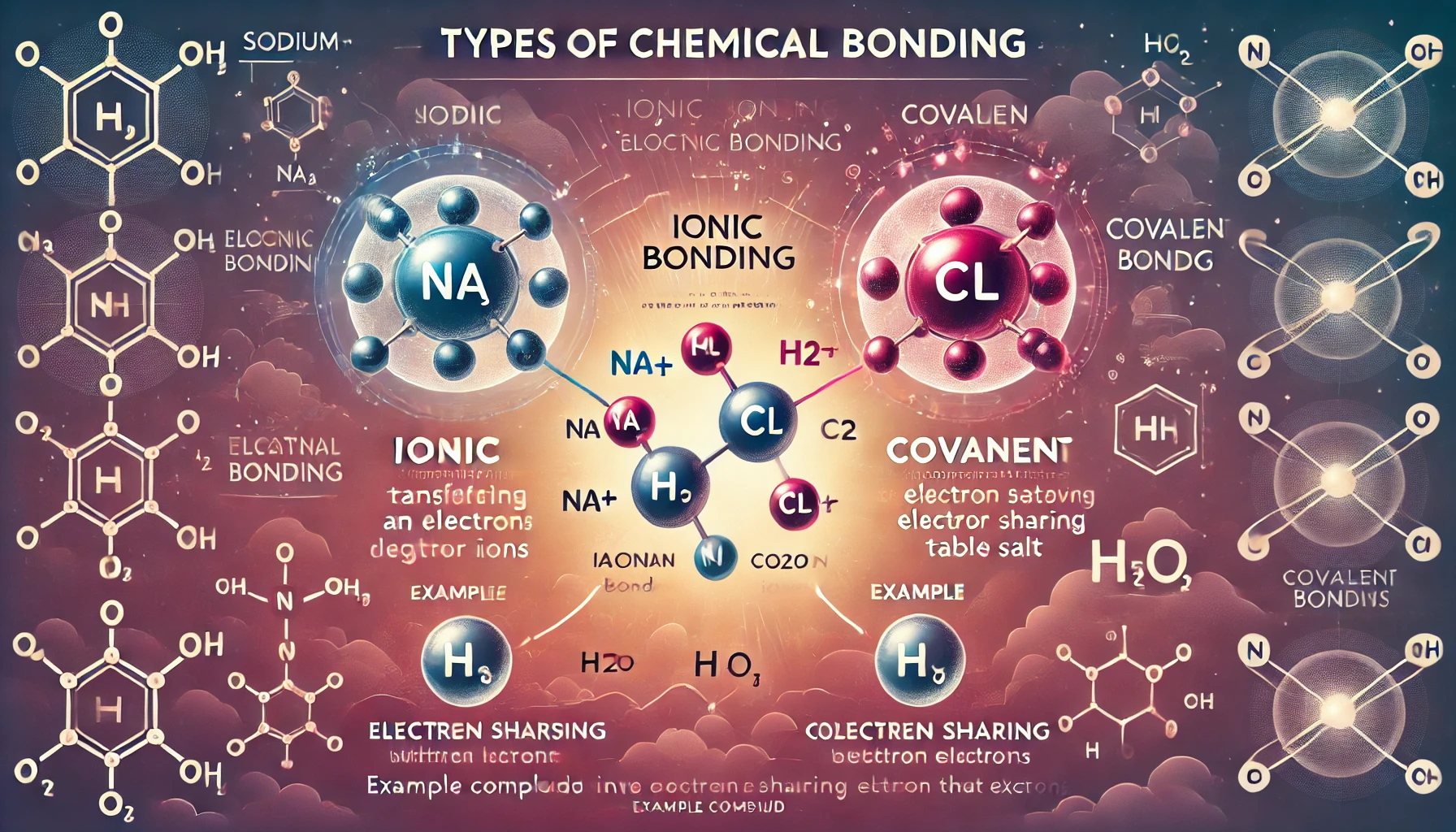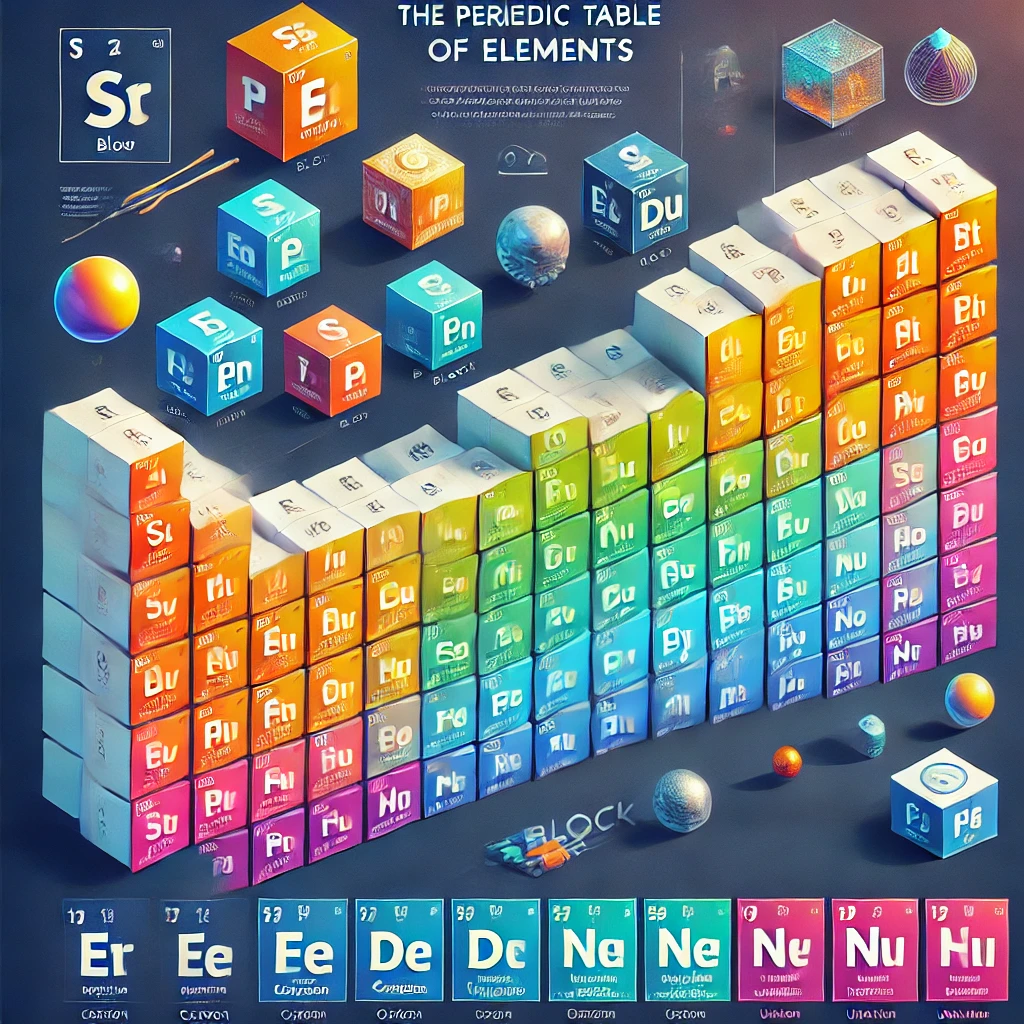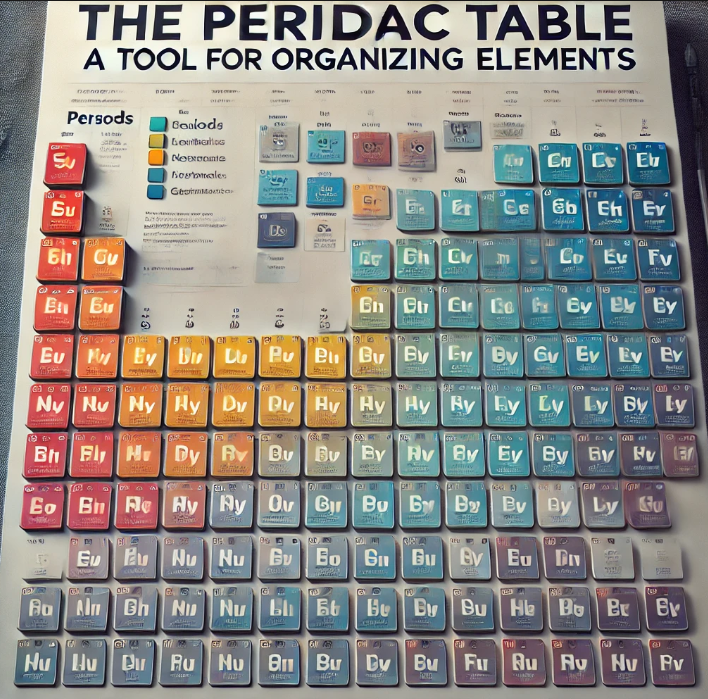Types of Chemical Bonding, Ionic and Covalent Bonding
Chemical bonding is the fundamental force that holds atoms together, forming the basis of all chemical compounds. Understanding the nature of chemical bonds is crucial for explaining the physical and chemical properties of substances. Among the various types of chemical bonding, ionic and covalent bonds are the most prominent. This discussion provides a comprehensive and critical analysis of these bonding types, their formation, properties, and significance in chemical structures.
Chemical Bonding: An Overview
Chemical bonding arises due to the interaction of atoms striving to achieve a stable electronic configuration, often by completing their valence shells. The two major types of bonds—ionic and covalent—differ significantly in their formation and characteristics. While ionic bonding results from the complete transfer of electrons, covalent bonding involves the sharing of electrons.
Ionic Bonding
Formation of Ionic Bonds
Ionic bonding occurs between atoms with a large difference in electronegativity, typically between metals and nonmetals. The metal atom donates one or more electrons to the nonmetal, resulting in the formation of oppositely charged ions. These ions are then held together by strong electrostatic forces.
Example: Sodium Chloride (NaCl)
- Sodium (Na) has one valence electron, which it donates to chlorine (Cl), forming a Na⁺ cation and a Cl⁻ anion.
- The resulting electrostatic attraction between Na⁺ and Cl⁻ forms a stable ionic compound, NaCl.
Properties of Ionic Compounds
- High Melting and Boiling Points: Strong electrostatic forces require significant energy to break.
- Solubility in Water: Most ionic compounds dissolve in polar solvents due to ion-dipole interactions.
- Electrical Conductivity: Solid ionic compounds are poor conductors, but when melted or dissolved in water, they conduct electricity due to the mobility of ions.
- Brittle Nature: When stress is applied, the crystal lattice shifts, causing like-charged ions to repel, leading to cleavage.
Critical Analysis of Ionic Bonding
While ionic bonding is responsible for the stability of many essential compounds, it also has limitations. The rigid lattice structure makes ionic compounds brittle and less flexible for applications requiring ductility. Additionally, ionic compounds have low conductivity in solid-state, limiting their use in electrical applications unless they are in molten or dissolved form.
Covalent Bonding
Formation of Covalent Bonds
Covalent bonding occurs between atoms with similar electronegativities, typically nonmetals, where electrons are shared between atoms to achieve stability. Depending on the number of shared electrons, covalent bonds can be single, double, or triple.
Example: Water (H₂O)
- Oxygen shares one electron each with two hydrogen atoms, forming two single covalent bonds.
Properties of Covalent Compounds
- Lower Melting and Boiling Points: Weak intermolecular forces result in lower thermal stability.
- Poor Electrical Conductivity: Covalent compounds lack free-moving ions, making them insulators.
- Diverse Physical States: Covalent compounds exist in all three states—solid, liquid, and gas.
- Varied Solubility: Some dissolve in nonpolar solvents, while others dissolve in polar solvents.
Critical Analysis of Covalent Bonding
While covalent bonding allows for molecular flexibility and diverse structures (e.g., organic molecules, polymers), it has limitations. Covalent compounds generally do not conduct electricity, restricting their application in electrical industries. Moreover, some covalent compounds, like diamond and graphite, show exceptional properties due to unique bonding structures, highlighting the complexity within this category.
| Feature | Ionic Bonding | Covalent Bonding |
|---|---|---|
| Electron Transfer | Complete transfer of electrons | Sharing of electrons |
| Bond Strength | Strong electrostatic forces | Weaker than ionic bonds |
| Electrical Conductivity | Conductive in molten/solution state | Poor conductor |
| Melting/Boiling Points | High | Low to moderate |
| Solubility | Generally soluble in water | Solubility varies |
| Physical Properties | Hard, brittle | Can be soft or hard |
Both ionic and covalent bonding are fundamental to the structure and function of chemical compounds. Ionic bonds create stable, crystalline solids with high thermal stability and electrical conductivity in solution, while covalent bonds form a diverse range of compounds with various physical states and functionalities. The choice of bonding type dictates the compound’s properties, influencing its applications in fields like material science, biochemistry, and industrial chemistry. A deeper understanding of these bonding mechanisms allows for innovations in designing new materials and pharmaceuticals.
Questions and Answers
Why do atoms form chemical bonds?
Answer: Atoms form chemical bonds to achieve a stable electronic configuration, usually by completing their valence shell (octet rule for most elements). This lowers their energy and increases stability.
Why are ionic compounds usually solid at room temperature while many covalent compounds exist as gases or liquids?
Answer: Ionic compounds have strong electrostatic forces between oppositely charged ions, forming a rigid crystal lattice that requires high energy to break. In contrast, covalent compounds have weaker intermolecular forces, allowing them to exist as gases or liquids.
Why do ionic compounds conduct electricity in molten or aqueous states but not in solid state?
Answer: In solid-state, ionic compounds have fixed ions in a crystal lattice and cannot move freely. In molten or aqueous states, ions are free to move and carry electric charge, allowing conductivity.
Why do covalent compounds generally have lower melting and boiling points compared to ionic compounds?
Answer: Covalent compounds are held together by weaker intermolecular forces (such as van der Waals forces or hydrogen bonds), requiring less energy to break compared to the strong electrostatic forces in ionic compounds.
Why is the formation of NaCl (sodium chloride) an example of ionic bonding, while the formation of H₂O (water) is an example of covalent bonding?
Answer: In NaCl, sodium (metal) donates an electron to chlorine (nonmetal), forming Na⁺ and Cl⁻ ions held together by electrostatic forces. In H₂O, oxygen and hydrogen share electrons to form covalent bonds.
Why is NaCl soluble in water but not in nonpolar solvents like benzene?
Answer: Water is a polar solvent and can stabilize Na⁺ and Cl⁻ ions through ion-dipole interactions. Nonpolar solvents like benzene lack these interactions and cannot dissolve ionic compounds.
Why do covalent bonds allow for the existence of molecules with diverse structures, such as DNA and proteins?
Answer: Covalent bonds can form single, double, or triple bonds and create complex 3D structures with different functional groups, enabling molecular diversity and biological functionality.
Why are diamond and graphite both covalent structures but exhibit vastly different physical properties?
Answer: Diamond has a 3D tetrahedral structure with strong covalent bonds in all directions, making it extremely hard. Graphite has layers of hexagonal rings with weak van der Waals forces between layers, making it soft and slippery.
Why do metals tend to form ionic bonds with nonmetals rather than covalent bonds?
Answer: Metals have low electronegativity and readily lose electrons, while nonmetals have high electronegativity and gain electrons. This electron transfer leads to ionic bonding rather than sharing electrons in covalent bonds.
Why does the electronegativity difference between atoms determine whether a bond is ionic or covalent?
Answer: A large electronegativity difference (≥1.7) leads to electron transfer and ionic bonding, while a small difference (<1.7) leads to electron sharing and covalent bonding.
Can a molecule contain both ionic and covalent bonds? If so, give an example and explain how this is possible.
Answer: Yes, compounds like Na₂SO₄ (sodium sulfate) contain both ionic and covalent bonds. The Na⁺ and SO₄²⁻ ions form ionic bonds, while the sulfate ion itself has covalent bonds between sulfur and oxygen.
Why are ionic compounds generally more brittle than metallic or covalent network solids?
Answer: When stress is applied, like-charged ions in the crystal lattice of ionic compounds come close to each other and repel, causing the structure to break. Covalent networks and metals have more flexible bonding arrangements.
Why do some covalent compounds dissolve in water while others do not?
Answer: Polar covalent compounds (like sugar) dissolve in water due to hydrogen bonding, whereas nonpolar covalent compounds (like oil) do not interact favorably with water and remain insoluble.
Why is it that some covalent molecules, such as CO₂, are nonpolar while others, such as H₂O, are polar?
Answer: The shape of CO₂ is linear, and the dipoles cancel out, making it nonpolar. In H₂O, the bent shape prevents dipole cancellation, making it polar.
If two elements have nearly the same electronegativity, what type of bond will they most likely form? Why?
Answer: They will most likely form a covalent bond because neither atom can fully transfer electrons to the other, leading to electron sharing.
Why are ionic compounds used in batteries and electrical applications?
Answer: In dissolved or molten states, ionic compounds conduct electricity due to the movement of free ions, making them useful in batteries and electrolytes.
Why are covalent compounds commonly found in biological systems and organic molecules?
Answer: Covalent compounds can form complex molecules with stable yet flexible structures, essential for biomolecules like DNA, proteins, and carbohydrates.
Why does table salt (NaCl) dissolve in water but sand (SiO₂) does not, even though both contain strong bonds?
Answer: NaCl dissolves due to strong ion-dipole interactions, while SiO₂ is a covalent network solid with strong Si-O bonds that water cannot break easily.
Why do ionic bonds play a crucial role in the properties of minerals and salts?
Answer: Ionic bonds provide structural rigidity, high melting points, and solubility in water, making them fundamental to minerals and salts.
Why is water (H₂O) considered essential for life in terms of its bonding and properties?
Answer: Water has strong hydrogen bonds that enable high heat capacity, solvent ability, and cohesive properties, making it vital for biological processes.
Why do atoms form chemical bonds?
a) To increase their energy
b) To achieve a stable electronic configuration
c) To gain more protons
d) To decrease their atomic number
Answer: b) To achieve a stable electronic configuration
Which of the following is an example of an ionic compound?
a) CO₂
b) H₂O
c) NaCl
d) CH₄
Answer: c) NaCl
Which type of bond involves the sharing of electrons?
a) Ionic bond
b) Covalent bond
c) Metallic bond
d) Hydrogen bond
Answer: b) Covalent bond
Ionic bonds are usually formed between:
a) Two nonmetals
b) A metal and a nonmetal
c) Two metals
d) Noble gases
Answer: b) A metal and a nonmetal
Which of the following compounds contains a covalent bond?
a) KBr
b) NaCl
c) CO₂
d) MgO
Answer: c) CO₂
Why do ionic compounds have high melting points?
a) They contain weak intermolecular forces
b) They have strong electrostatic attractions between ions
c) Their atoms are loosely packed
d) They contain metallic bonds
Answer: b) They have strong electrostatic attractions between ions
Why do covalent compounds generally not conduct electricity?
a) They do not contain charged particles
b) They have free-moving electrons
c) They contain delocalized ions
d) They dissolve only in ionic solvents
Answer: a) They do not contain charged particles
Which of the following statements about covalent bonds is TRUE?
a) They always form between two metals
b) They involve the transfer of electrons
c) They are stronger than ionic bonds
d) They involve the sharing of electrons
Answer: d) They involve the sharing of electrons
Why do ionic compounds dissolve in water?
a) Water is a nonpolar solvent
b) Water molecules attract and separate the ions
c) Water molecules break covalent bonds
d) Water has a high boiling point
Answer: b) Water molecules attract and separate the ions
Which of the following covalent compounds is polar?
a) CO₂
b) CH₄
c) H₂O
d) N₂
Answer: c) H₂O
Which of the following best describes the bonding in NH₄Cl?
a) Only ionic bonds
b) Only covalent bonds
c) Both ionic and covalent bonds
d) Only metallic bonds
Answer: c) Both ionic and covalent bonds
Which of the following compounds is an example of a covalent network solid?
a) NaCl
b) CO₂
c) Diamond (C)
d) H₂O
Answer: c) Diamond (C)
What happens when an ionic compound is struck with force?
a) It bends
b) It shatters
c) It melts immediately
d) It becomes more conductive
Answer: b) It shatters
Why does graphite conduct electricity while diamond does not, even though both are made of carbon?
a) Diamond has free-moving electrons
b) Graphite has delocalized electrons
c) Diamond is more reactive than graphite
d) Graphite has ionic bonds
Answer: b) Graphite has delocalized electrons
Which of the following explains why noble gases do not form chemical bonds easily?
a) They have unstable electron configurations
b) They have low melting points
c) Their outermost electron shell is full
d) They have low ionization energy
Answer: c) Their outermost electron shell is full
Which type of bond is responsible for the high boiling point of water?
a) Ionic bond
b) Metallic bond
c) Hydrogen bond
d) Covalent bond
Answer: c) Hydrogen bond
Which property allows ionic compounds to conduct electricity in molten form but not in solid form?
a) The movement of electrons
b) The presence of free-moving ions
c) The presence of delocalized protons
d) The ability to form hydrogen bonds
Answer: b) The presence of free-moving ions
Which of the following is an example of an ionic crystal?
a) Sugar
b) Diamond
c) Table salt (NaCl)
d) Water
Answer: c) Table salt (NaCl)
Which of the following is most likely to form a triple covalent bond?
a) H₂
b) O₂
c) N₂
d) Cl₂
Answer: c) N₂
What kind of bond holds the two oxygen atoms together in an O₂ molecule?
a) Single covalent bond
b) Double covalent bond
c) Triple covalent bond
d) Ionic bond
Answer: b) Double covalent bond



I have learned a lot from this website. The content is informative, well-structured, and easy to understand. Thank you for providing such valuable knowledge!